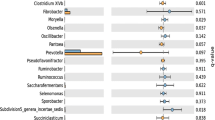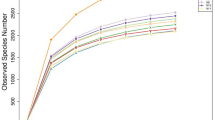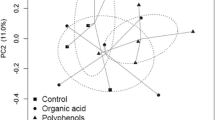Abstract
Anin vitro study in dual-flow continuous-culture fermentors was conducted with two different concentrations of monensin, cinnamaldehyde or garlic extract added to 1:1 forage-to-concentrate diet in order to determine their effects on selected rumen bacterial populations. Samples were subjected to total DNA extraction, restriction analysis of PCR amplified parts of 16S rRNA genes (ARDRA) and subsequent analysis of the restriction profiles by lab-on-chip technology with the Agilent’s Bioanalyser 2100. Eub338-BacPre primer pair was used to select for the bacteria from the generaBacteroides, Porphyromonas andPrevotella, especially the latter representing the dominant Gram-negative bacterial population in the rumen. Preliminary results ofHaeIII restriction analysis show that the effects of monensin, cinnamaldehyde and garlic extract on the BacPre targeted ruminal bacteria are somewhat different in regard to targeted populations and to the nature of the effect. Garlic extract was found to trigger the most intensive changes in the structure of the BacPre targeted population. Comparison of thein silico restriction analysis of BacPre sequences deposited in different DNA databanks and of the results of performed amplified ribosomal DNA restriction analysis showed differences between the predicted and obtainedHaeIII restriction profiles, and suggested the presence of novel, still unknownPrevotella populations in studied samples.
Similar content being viewed by others
References
Amann R.I., Ludwig W., Schleifer K.H.: Phylogenetic identification andin situ detection of individual microbial cells without cultivation.Microbiol.Rev.59, 143–169 (1995).
Avguštin G., Wright F., Flint H.J.: Genetic diversity and phylogenetic relationship among strains ofPrevotella (Bacteroides)ruminicola from the rumen.Internat.J.Syst.Bacteriol.44, 246–255 (1994).
Avguštin G., Ramšak A., Peterka M.: Systematics and evolution of ruminal species of the genusPrevotella.Folia Microbiol.46, 40–44 (2001).
Avguštin G., Tepšič K.: The genetic diversity of CFB bacteria (theBacteroidetes) inhabiting the bevine hindgut, p. 49 in1st FEMS Congr. Europ. Microbiologists, Ljubljana (Slovenia) 2003.
Broudiscou L.P., Lassalas B.: Effects ofLavandula officinalis andEquisetum arvense dry extracts and isoquercitrin on the fermentation of diets varying in forage contents by rumen microorganisms in batch culture.Reprod.Nutr.Dev.40, 431–440 (2000).
Busquet M., Calsamiglia S., Ferret A., Kamel C.: Effects of cinnamaldehyde, garlic and monensin on nitrogen metabolism and fermentation profile in continuous culture.J.Aniim.Sci.81 (Suppl. 1), 148 (2003).
Cardozo P., Calsamiglia S., Ferret A.: Effects of natural plant extracts on nitrogen metabolism and fermentation profile in continuous culture.J.Anim.Sci.79 (Suppl. 1), 78 (2001).
Chang S.T., Chen P.F., Chang S.C.: Antibacterial activity of leaf essential oils and their constituents fromCinnamomum osmopholeum.J.Ethnopharm.77, 123–127 (2001).
Chopra I., O’Neill A.J., Miller K.: The role of mutators in the emergence of antibiotic-resistance bacteria.Drug Resist.Update6, 137–145 (2003).
Cowan M.M.: Plant products as antimicrobial agents.Clin.Microbiol.Rev.12, 564–582 (1999).
European Union 1998. Press Release No. 14127. Agriculture Council, 14 December 1998.
Nagaraja T.G.: Ionophores and antibiotics in ruminants, pp. 173–204 in R.J. Wallace, A. Chesson (Eds):Biotechnology in Animal Feeds and Animals Feeding. VCH Verlagsgesellschaft, Weinheim (Germany) 1995.
Nagaraja T.G., Taylor M.B.: Susceptibility and resistance of ruminal bacteria to antimicrobial feed additives.Appl.Environ.Microbiol.53, 1620–1625 (1987).
Newbold C.J., Wallace R.J.: Effects of the ionophores monensin and tetronasin on simulated development of ruminal lactic acidosisin vitro.Appl.Environ.Microbiol.54, 2981–2985 (1988).
Ramšak A., Peterka M., Tajima K., Martin J.C., Wood J., Johnston M.E.A., Aminov R.I., Flint H.J., Avguštin G.: Unraveling the genetic diversity of ruminal bacteria belonging to the CFB phylum.FEMS Microbiol.Ecol.33, 69–79 (2000).
Reilly K., Attwood G.T.: Detection ofClostridium proteoclasticum and closely related strains in the rumen by competitive PCR.Appl.Environ.Microbiol.64, 907–913 (1998).
Sliwinski B.J., Kreuzer M., Wettstein H.R., Machmuller A.: Rumen fermentation and nitrogen balance of lambs fed diets containing plant extracts rich in tannins and saponins, and associated emissions of nitrogen and methane.Arch.Anim.Nutr.56, 379–392 (2002).
Tajima K., Aminov R., Nagamine T., Ogata K., Nakamura M., Matsui H., Benno Y.: Rumen bacterial diversity as determined by sequence analysis of 16S rDNA libraries.FEMS Microbiol.Ecol.29, 159–169 (1999).
Tajima K., Aminov R.I., Nagamine T., Matsui H., Nakamura M., Benno Y.: Diet-dependent shifts in the bacterial population of the rumen revealed with real-time PCR.Appl.Env.Microbiol.67, 2766–2774 (2001).
Watanabe K., Watanabe J., Kuramitsu S., Maruyama H.B.: Comparison of the activity of ionophores with other antibacterial agents against microbes.Antimicrob.Agents Chemother.19, 519–525 (1981).
Whitford M.F., Forster R.J., Beard C.E., Gong J., Teather R.M.: Phylogenetic analysis of rumen bacteria by comparative sequence analysis of cloned 16S rRNA genes.Anaerobe4, 153–163 (1998).
Wood J., Scott K.P., Avguštin G., Newbold C.J., Flint H.J.: Estimation of the relative abundance of different bacteriodes and prevotella ribotypes in gut samples by restriction enzyme profiling of PCR-amplified 16S rRNA gene sequences.Appl.Environ.Microbiol.64, 3683–3689 (1998).
Author information
Authors and Affiliations
Corresponding author
Additional information
This project was funded byAXISS France SAS (Bellegarde-sur-Valserine, France).
Rights and permissions
About this article
Cite this article
Ferme, D., Banjac, M., Calsamiglia, S. et al. The effects of plant extracts on microbial community structure in a rumen-simulating continuous-culture system as revealed by molecular profiling. Folia Microbiol 49, 151–155 (2004). https://doi.org/10.1007/BF02931391
Received:
Revised:
Issue Date:
DOI: https://doi.org/10.1007/BF02931391




